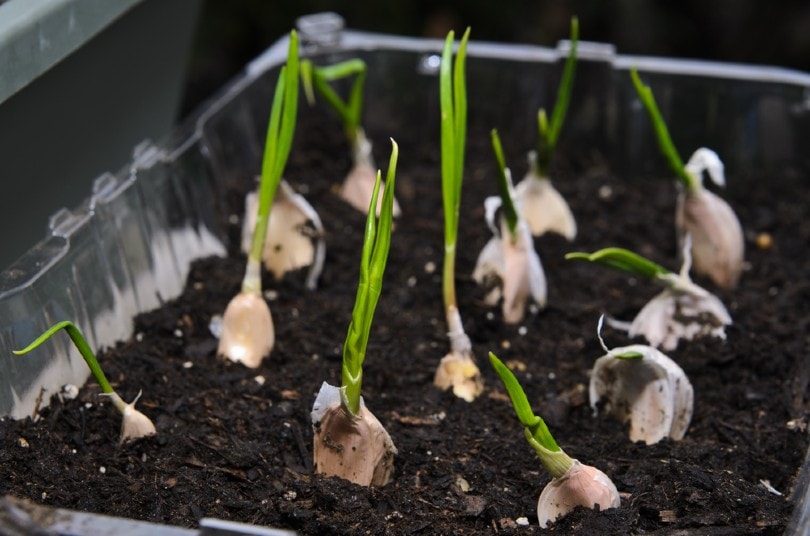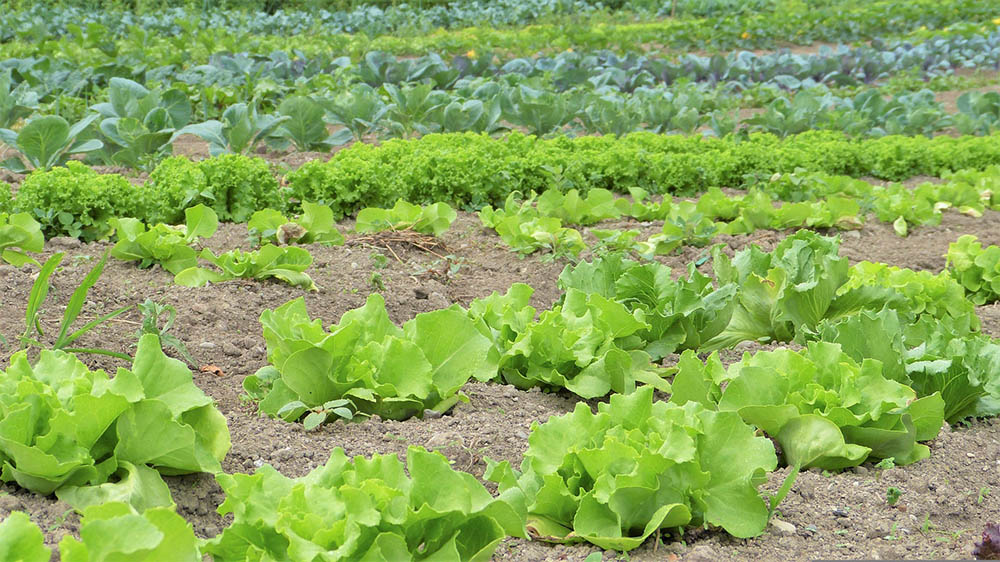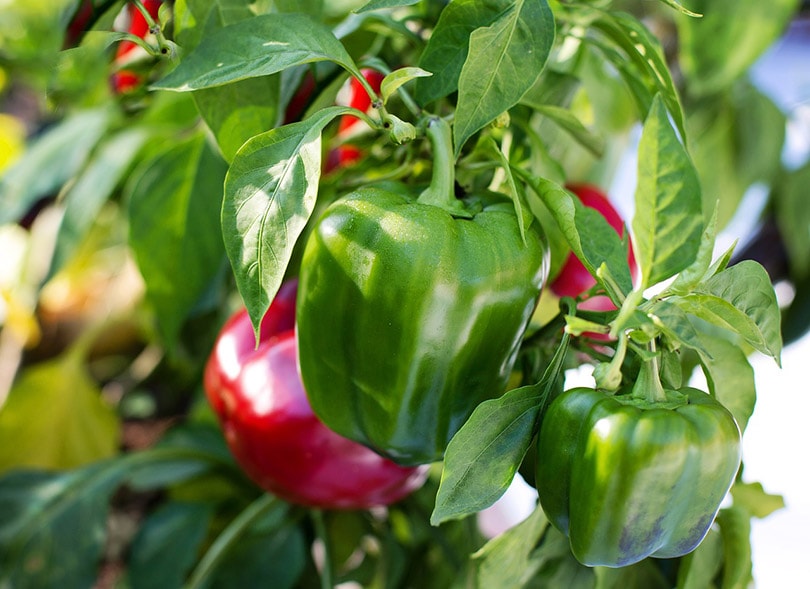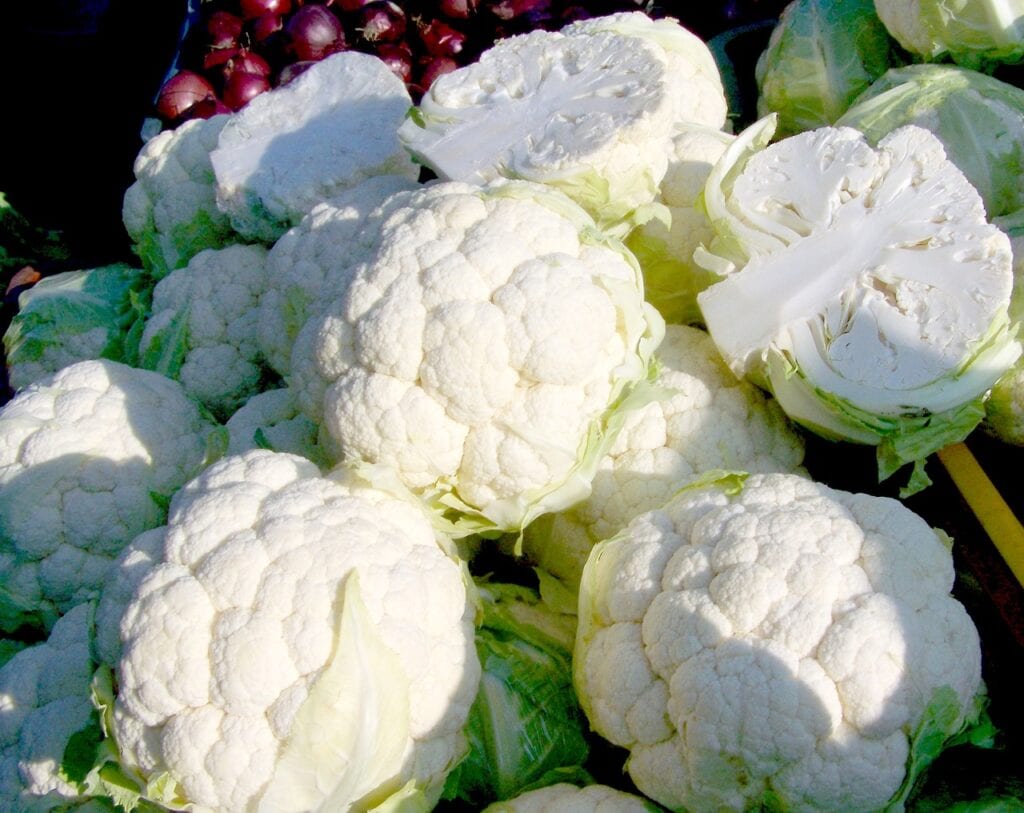10 Companion Plants for Garlic (With Pictures)
-
Jana Blagojevic
- Last updated:

Garlic is a fragrant vegetable that belongs to the family of Alliums, along with onions, chives, and leeks. Garlic has a unique spicy aroma, making it one of the favorite spices worldwide. Its flavor is a necessary component in many specialties, including pasta, chicken, pizza, potato dishes, salads, dressings, and many others. Other than being an excellent spice in many dishes, garlic is a rewarding plant to grow in any garden. It helps many plants repel unwanted and harmful pests, and it enhances the growth of many herbs and vegetables.
Many plants enjoy growing next to garlic and brings many benefits, while some can negatively affect its growth. To learn which plants are excellent companions for garlic, read on below.
The 10 Companion Plants for Garlic
1. Cabbage

| Botanical name | Brassica oleracea var. capitata |
| Growing conditions | Full sun; rich, fertile, well-drained soil. |
| Benefits | Garlic keeps many insects and pests away; same growth requirements. |
Garlic has many benefits for garden plants and vegetables; one particular vegetable that benefits from garlic is cabbage. It has a unique fragrance and spicy aroma, which keeps many unwanted guests at bay. Garlic is known to repel pests such as cabbage loopers, diamondback moths, and worms, a common nuisance for cabbage. Garlic is also an excellent companion plant with cabbage because it will keep away rabbits, squirrels, moose, and deer with their unusual smell.
2. Peppers

| Botanical name | Capsicum annuum |
| Growing conditions | Plenty of sunlight; well-drained soil. |
| Benefits | Pepper provides garlic with shade; garlic keeps pests and fungi off peppers. |
While peppers are sun-loving plants with the same growing requirements as garlic, they attract many insects and pests. Since peppers are prone to insect infestations, garlic is an excellent companion plant. The specific scent of garlic repels insects that may attack and hurt peppers. If you plant peppers and garlic as companion plants, you can expect them to grow healthy together without the risk of attracting pests, white mold, or blight. Garlic benefits from peppers because the pepper’s foliage will provide natural shade during the scorching summer days.
3. Potatoes

| Botanical name | Solanum tuberosum |
| Growing conditions | Full sun; fertile, moist, and acidic soil. |
| Benefits | Same growing conditions; sulfur from the garlic helps the potatoes to repel pests. |
Potatoes and garlic enjoy almost entirely the same conditions for growing. If you decide to plant these two vegetables together, you could maintain and care for them in the same way. Potatoes benefit from garlic greatly, especially because garlic releases sulfur into the soil. Once potatoes pick up on the sulfur in the soil, they can repel certain insects and pests. Garlic repels pests with its unique aroma, and planting it as a companion plant for potatoes will bring outstanding results to both vegetables.
4. Spinach

| Botanical name | Spinacia oleracea |
| Growing conditions | Full sun or partial shade; moist, nitrogen-rich soil. |
| Benefits | Same growing requirements, spinach is a weed barrier for garlic. |
Spinach is a low-growing vegetable with similar properties to garlic and enjoys receiving the same treatment. Both these vegetables are hardy and will be excellent companions through winter. Spinach has amazing effects being planted near garlic, and the most significant benefit it brings is acting as a weed barrier. The only thing to remember is to plant a variety of spinach that grows only up to 6 or 9 inches, otherwise, it will overshadow your garlic plants.
5. Dill

| Botanical name | Anethum graveolens |
| Growing conditions | Full sun; moist, well-drained, fertile soil. |
| Benefits | Dill increases the flavor of garlic and repels harmful insects. |
Dill is a lovely herb in the celery family that’s used in many dishes worldwide. It has a delicate root system, so planting it between garlic plants would be ideal for keeping them safe through harvest. Both these plants bring incredible benefits to one another. Garlic helps dill keep away all unwanted pests that may harm the plant. On the other hand, dill is an excellent companion plant to garlic because it increases its flavor and repels insects like moths, worms, and thrips.
6. Cauliflower

| Botanical name | Brassica oleracea var. botrytis |
| Growing conditions | Full sun; moist, well-drained, fertile soil. |
| Benefits | Garlic keeps insects like aphids, worms, and moths away from cauliflower. |
Cauliflower is a vegetable similar to cabbage, regarding the effects it can bring when planted near garlic. Cauliflower is a plant prone to pest infestations like aphids, cabbage worms, and moths. These insects dislike the smell and taste of garlic, so planting it as a companion plant for cauliflower is a wise idea.
7. Kale

| Botanical name | Brassica oleracea var. sabellica |
| Growing conditions | Full sun or partial shade; loamy, fertile, well-drained soil. |
| Benefits | Kale takes up very little space, leaving plenty of room for garlic; garlic keeps unwanted pests away. |
Kale is another vegetable that is prone to aphid and mite infestations. Planting garlic near kale can significantly impact the vegetable and keep any unwanted insects away. Kale also has beneficial properties for garlic, being a vegetable that requires very little space to grow, leaving plenty of room for garlic to spread. While kale is a cool-weather plant, these two enjoy the same growing conditions and require very little maintenance.
8. Tomatoes

| Botanical name | Solanum lycopersicum |
| Growing conditions | Warm weather; full sun; well-drained, slightly acidic soil. |
| Benefits | Garlic helps keep spider mites and aphids away from tomatoes. |
Tomatoes are a vegetable that can sometimes be tricky to grow, especially being prone to so many insect attacks. Since garlic is excellent at repelling pests, planting it in between rows of tomatoes can significantly improve the vegetable’s health. Another way to let your young tomato plants benefit from garlic is to plant them in rows where you previously harvested garlic. Doing so will keep away insects like spider mites and aphids, a common nuisance for tomatoes.
9. Chamomile

| Botanical name | Matricaria chamomilla |
| Growing conditions | Full sun or partial shade; well-drained, rich soil. |
| Benefits | Enhances and improves the flavor. |
Chamomile is a lovely sweet-tasting herb that is an excellent companion plant for garlic. Planting these two together will improve and enhance the taste of both plants. Chamomile is also valuable if you don’t enjoy the aroma of garlic since its sweet fragrance tends to overshadow garlic. They will enjoy growing in the same conditions, so once the risk of frost is gone, you’ll be safe to grow these low-maintenance plants.
10. Rue

| Botanical name | Ruta graveolens |
| Growing conditions | Full sun; fast draining, sandy soil. |
| Benefits | Enhance the flavor; repels onion maggots and onion flies. |
Rue is another excellent companion plant for garlic, with similar beneficial effects as dill and chamomile. This plant will enhance the flavor of garlic and help repel some of the most common pests that attack the vegetable. Garlic is prone to onion maggots and onion flies. Onion maggots are incredibly harmful to garlic and can significantly degrade the garlic bulbs, and onion maggots and flies dislike the smell of Rue and will stay away from it.
Worst Companion Plants for Garlic

- Asparagus – Asparagus and garlic aren’t great companion plants and should be planted at a great distance away from each other. Allium plants, including garlic, tend to stunt the growth of asparagus.
- Beans – Garlic can affect beans negatively when planted close together. It is best to plant beans away to prevent garlic from stunting their growth.
- Peas – Make sure to keep peas away from your garlic because these two plants don’t do too well together. Since peas have short roots, garlic may inhibit the growth of their roots.
- Parsley – Parsley is another plant that cannot achieve its full glory when planted near garlic or other allium plants. Its development will be stunted, so it’s better to plant this at a reasonable distance.
- Sage – Alliums, including garlic, prefer growing in rich, slightly moist, and well-draining soil, while sage thrives in a dry and sandy environment. These two don’t grow in the same conditions, so it’s better to plant them apart.
In Conclusion
After reading about the best companion plants for garlic, you should have a better insight into your various possibilities. Be careful when pairing plants with alliums because this vegetable has particular growing requirements that you must meet to have a strong and healthy garlic plant. Once you learn the perfect matches, you will create a lovely and diverse garden filled with fragrant herbs and vegetables that enhance each other’s growth.
See also:
Featured Image Credit: JeepFoto, Shutterstock
Contents
